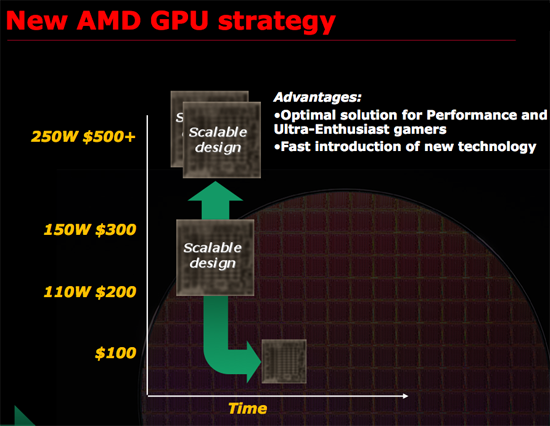The RV770 Story: Documenting ATI's Road to Success
by Anand Lal Shimpi on December 2, 2008 12:00 AM EST- Posted in
- GPUs
If it Ain’t Broke...
The status quo is a dangerous thing. In 2005 ATI and NVIDIA were both sitting on a formula that worked: build the fastest GPU in the world (and provide solid drivers), and you’d win the market. By this point ATI had years of support to continue building GPUs this way, but there were a few within the company who believed it was time for a change.
In many ways ATI and NVIDIA were just taking different risks. NVIDIA had learned its lesson with transitioning to new manufacturing processes too quickly and would most likely build GT200 on an older, more mature process, burdening it with a huge die. ATI opted to do what NVIDIA wouldn’t and move to new manufacturing processes quicker, aiding it in producing GPUs with smaller dies.
With its only competitor hell bent on making bigger and bigger GPUs, ATI took care of half of the problem - it would be free to do whatever it’d like, without any real competition. The question then became - could it work?

It’s easy to, today, look back and say “of course” but you have to understand that this was 2005 and the first specifications of RV770 were being drafted. Imagine sitting at a table full of people whose jobs were supported by building the biggest GPUs in the world and suggesting that perhaps we sit this round out. Let NVIDIA take the crown, let them have the halo part, we’ll compete in the $200 - $300 market. Yeah, right.
What followed were heated debates, if ATI were to stake the future of its graphics business on not building the absolute faster GPU, but rather a GPU targeted at a lower market segment the proposition was risky.
ATI viewed the graphics market as five segments: Enthusiast, Performance, Balance, Mainstream and Value. In the Spring of 2005, ATI decided to shoot for the Performance segment, and not Enthusiast. You could even argue that the Performance segment is what the R300 competed in back in 2002, priced at $399 it was closer to the $299 MSRP of the Radeon HD 4870 than the $599 MSRP of the GeForce GTX 280 when it launched. But ATI viewed this as a change in strategy, while R300 aimed for performance regardless of die size, RV770 would have clear power and die size limits imposed on it.
There were many individuals at ATI that were responsible for the RV770 we know today getting green lighted. ATI’s Rick Bergman was willing to put himself and his career on the line, because if this didn’t work, he’d be one to blame. Carrell recalled a story where Rick Bergman and others were at a table discussing RV770; Rick turned to Matt Skynner and asked him if he thought they could really do it, if they could make RV770 a smaller-than-NVIDIA GPU and still be successful, if it was possible to create a halo in the Performance segment. Matt apparently pondered the question, turned to Rick and said “I think we can”. Carrell felt that ATI might not have gone down that path if it weren’t for Matt Skynner’s support and Rick Bergman making sure that the project was executed as well as it ended up being.
It was far from rosy at that point however, there were many very smart engineers, people who were responsible for things like R300 and R580 who disagreed with the strategy. People who had been right before were saying that if ATI didn’t build a true competitor to GT200 that the fight would be over. Then you had folks like Carrell saying that it could be done, that this was absolutely the right move. It’s much like the passion of politics, each side believed that they were right, but ultimately you can only pick one - and both sides have to live under the same roof.










116 Comments
View All Comments
PrinceGaz - Wednesday, December 3, 2008 - link
Now that is the sort of reason I visit AT every day. Superb article. Thanks Anand.1078feba - Thursday, December 4, 2008 - link
Couldn't agree more. Quite simply, this is the best article about hardware architecture I have ever had the distinct pleasure of reading. The human perspective adds an element of drama which cannot be underestimated. Very nearly reads like a Hollywood script, a la Jeff Bridges in "Tucker".Cheers Anand, bravo, well done.
fyleow - Wednesday, December 3, 2008 - link
Is this a typo? Did you mean to say Carrell instead of Carol?"Carol recalled a story where Rick Bergman and others were at a table discussing RV770; Rick turned to Matt Skynner and asked him if he thought they could really do it, if they could make RV770 a smaller-than-NVIDIA GPU and still be successful, if it was possible to create a halo in the Performance segment."
Kromis - Wednesday, December 3, 2008 - link
Watching too much of "The Office", eh?I kid, I kid. (Good show, by the way)
erikejw - Sunday, December 7, 2008 - link
A really really good article with lots of good info.I think though that it is sad that you missed the opportunity to get the best insight you can into future GPU trends and technology for the coming years. That would have been an even better article.
rarson - Monday, April 24, 2017 - link
This post needs to be preserved for posterity.